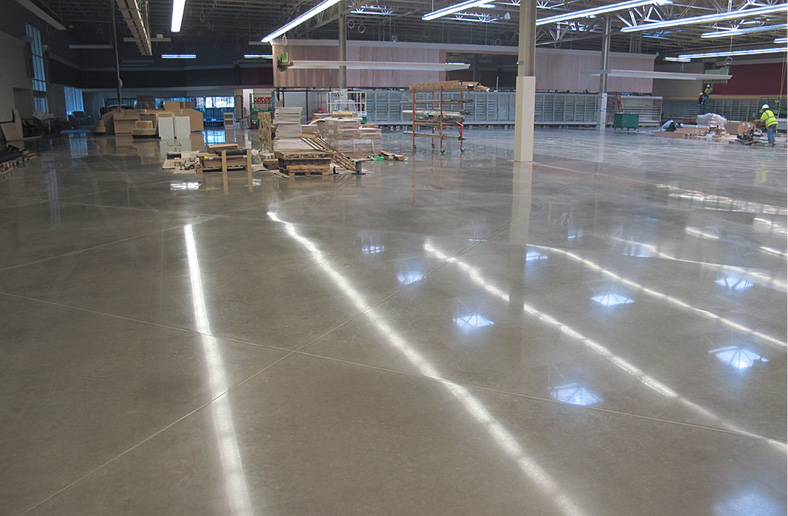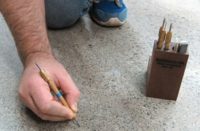
Over the last few years, I’ve noticed a shift in the polished concrete market. As the industry has grown, there has always been three sizes of contractors. There have been small contractors new in the business or contractors that focus on residential or extremely small commercial projects. These are generally one-to-three machine contractors who usually operate with small- to medium-sized grinding platforms. The owner runs each job and is intimately involved in managing each project. These are classified as small contractors.
There are mid-sized contractors with three to 10 grinders, most of which are larger-sized machines. These contractors have two or three small crews that can come together to make one larger crew if the project calls for more equipment and manpower.
There have also been a few larger contractors with 10 to 50 grinders. These large contractors have multiple trained crews equipped to complete mid-sized to large commercial projects. The industry has evolved over the last 15 to 20 years with these three groups forming the workforce.
Changes are happening
Over the last few years, there’s been a change. The medium-sized contractors seem to be disappearing rapidly. It seems the owners of these companies have made a conscious decision to either get smaller or larger.
If they choose to get smaller, they focus on higher-end projects that carry maximum margin. This allows them to lower overhead costs, keep only their best employees and control their installation costs closely. The owners I’ve talked to that decide to downsize make good margin without the heavy overhead or the higher risk that they had as a medium-sized contractor.
On the flip side of the coin, many owners have decided their best path to success is to grow larger. These contractors grow into the large-sized category through acquisition of other medium-sized contractors and/or aggressive pricing to gain market share. I’ve seen both paths lead to success, and I want to discuss the impacts of this shift on the polishing industry based on each group.

First up: Small contractors
By taking the lessons learned from performing small to mid-sized commercial work and using these lessons to streamline smaller projects where a higher per-foot price can be charged, contractors are maximizing their profits.
Small contractors are ideally suited for the highly decorative projects that require a high skill level. Having these projects completed by highly skilled craftsmen is very good for the long-term viability of the polished concrete industry. These high-end projects make the photos that manufacturers use to sell their products. They are the jewels that architects put forth to showcase their design capabilities.
The only drawback is that these small-sized, but highly skilled, contractors make it much more difficult for new contractors to break into the industry. Over the last 10 years especially, there’s been a plethora of new contractors coming into the market. While this type of rapid growth is fantastic for a new industry looking for validity, a mass influx of untrained contractors who don’t have a good understanding of costs and intricacies of how to complete projects is not good for an established market.
We can compare the industry overall to a corporation. When first starting off in business, there’s nothing established to build on, so growth in the multiple hundreds of percent each year are fantastic for the first few years. However, as the company establishes a baseline, trying to double or triple sales each year becomes extremely risky. The amount of capital frantically expended trying to keep up with this much growth leads to losses in customer service and quality.
A slow and steady marginal growth is preferred because you can plan for it. You can train and grow the workforce to keep up with the marginal expansion where no training can keep up with massive growth. That’s the current state of the polished concrete industry specifically related to new incoming contractors. The experience and quality level of the skilled, smaller contractors are putting a damper on the new contractors coming in.
This slows, but doesn’t entirely stop, new contractors from starting up. This provides a growth rate that is much easier for the industry as a whole to absorb. I see this as a great sign for our industry rather than a drawback.
Larger contractors and their impact
As the industry has matured, larger projects and larger overall multiproject contracts have become available. These are only able to be serviced by large national or regional contractors. The price point and the single-source accountability are tailor-made for large contractors with multiple trained crews.
These contracts or projects make up the bulk of the work being completed by our industry. Large contractors generally make up their margin on volume of footage rather than high-priced work. If the industry retained the price point at $5 or $6 a foot like it had in 2005, the industry would be a fraction of its current size. The lower overall price point has allowed a lot more customers to specify polished concrete flooring that wouldn’t be feasible with a higher price point.
For example, retail grocery has traditionally used vinyl composition tile as its standard flooring. With an install cost of $2 a foot, it’s easy to see why this flooring is attractive. Additionally, the tile covering hides sins of low-quality concrete construction giving the appearance of a well-built building. VCT has a maintenance cost of $2 per foot or higher per year. The average grocery store has a reset or remodel scheduled every seven to 10 years. During this remodel, the VCT is generally removed and replaced. This is all costed out so that the store absorbs an even cost per year over the life of the floor.
Polished concrete has an average maintenance cost of about 75 cents per foot per year. The initial install cost is on average $3 to $4 a foot. The higher install cost can be absorbed when figured over the same seven- to 10-year period with a savings showing on the bottom line. The price had to get low enough to be advantageous not only to make the shift based on maintenance costs but also to absorb the higher initial construction cost to ensure the concrete is placed to a higher standard, thereby producing a better overall product.
The price per foot was lowered as contractors grew to a size that allowed them to train crews, maintain equipment and buy consumables at a point that could meet the customers’ most advantageous pricing. Like any other industry, bulk work doesn’t have to be as high quality as the smaller projects where imperfections are magnified. In turn, these larger contracts grow the industry overall and provide information and comparative programs that complement and benefit those smaller projects.
One example is maintenance. It’s easy to figure and track maintenance costs when large companies are tracking it. It’s hard to talk to your local bike shop owner or housewife and find out what they spend to take care of their floors.
Add manufacturers to the mix
There is a third group, the manufacturers, impacted by both the smaller and larger contractor models. Manufacturers need two things to grow or even maintain their market share — namely innovation and competitive pricing.
The large and small contractor groups affect the manufacturers in different ways. Generally speaking, smaller contractors are much more willing to experiment with products and processes in an attempt to find a better method. When the owner, who takes all the risk, is on site for each project the ability for trial and error is present and they’re willing to take that risk because of their faith in their experience and ability.
When the project is being completed without the owner present (as with most larger companies that travel), the willingness to allow crews to experiment is greatly diminished. Most of the industry’s innovation is contractor-driven and is completed by the smaller-sized contractors. Manufacturers use this fertile ground to test new products and processes before putting them out for general consumption.
The second need that manufacturers have is competitive pricing. Just like everything else, purchasing power drives prices. The larger contractors drive up these sales, allowing manufacturers better purchasing power.
Take cars, for example. When Ford makes its F-series trucks with the touchscreen dash, it buys thousands of those screens at $100 or so per unit. When Tesla buys a similar screen, it doesn’t have the mass numbers to drive down the pricing, so the screens cost $500 per unit.
Polished concrete manufacturers are the same way. The large contractors buy tremendous amounts of consumables. These large purchases allow manufacturers to negotiate their material suppliers into better pricing which lowers the overall cost of the goods available. This is a symbiotic relationship.
Pushing out the middle man
Smaller contractors provide high-end projects and continual innovation at a higher per-foot price. Larger contractors provide large amounts of footages, bring in bigger customers and drive down the price of goods. Each group wouldn’t be as efficient or successful without the other. I listen to frustration from both groups about the other, but only a few contractors realize the symbiotic nature of our industry and how the demise of one group or the other would have a major impact on the industry as a whole.
This isn’t to say there are no mid-sized contractors left, because I know there are. I just see the trend of contractors either getting bigger or smaller is making the mid-sized polished concrete contractor slowly disappear. In the end, I think this trend is good for our industry as a whole and mirrors other older and more established industries.
As the market ages I believe the trend will continue to accelerate. Manufacturers will become more successful based on their alliance with contractors. I’m seeing more manufacturer and contractor teams going after customers and projects. I think this is an interesting trend that will also make the industry stronger.
I also see how advantageous supply companies like Runyon Surface Prep, DecoPrep, Niagara Machine and Jon-Don are impacting the industry for the better. Having distributors with quality products and market knowledge is invaluable for both large and small contractors. These guys are definitely affecting the industry for the better.
Now, everything in this article is my opinion based on reviewing bids, submittals and having daily discussions with contractors all over the country and manufacturers. We’d be interested to hear your feedback or thoughts on this topic. If we get some good responses, we’ll publish them in an upcoming issue. As always, thanks for taking the time to read my article.
















